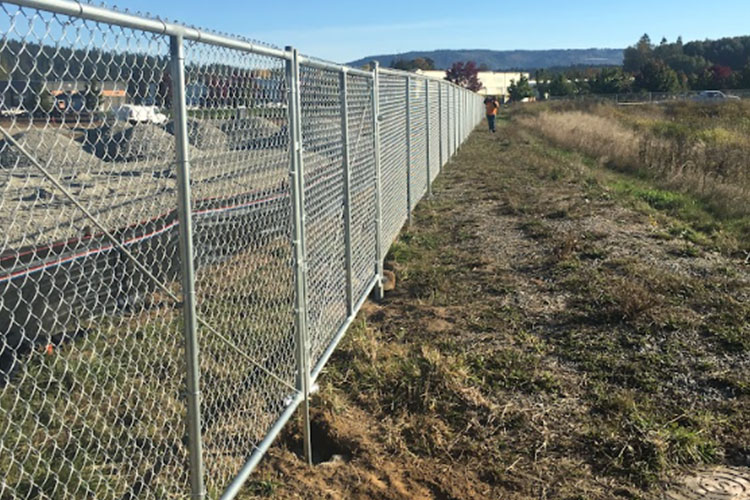A Comprehensive Overview to Fencing Install: What You Need to Know About Secure Fencing Provider
When it comes to setting up a fencing, you've obtained a whole lot to contemplate. You'll need to examine your property and decide if you want to deal with the installment yourself or hire a professional.
Understanding Various Kinds Of Fence Products
When you're picking a fence, understanding the different types of fence products is necessary. Each product provides special advantages and downsides, influencing your decision. Wood offers a traditional look and can be personalized, but it needs routine upkeep and may rot gradually. Plastic is low-maintenance and durable, resisting fading and insects, however it can be more expensive upfront. Chain-link fence is cost-efficient and functional for enclosing large areas, though it lacks privacy and visual appeal. Steel secure fencing, like wrought iron or light weight aluminum, provides strength and beauty however may require rust security. Composite materials blend the finest of wood and plastic, providing sturdiness with a natural look. Consider your budget, wanted looks, and upkeep preferences when examining these choices. Inevitably, selecting the best product will certainly assist you produce a fencing that satisfies your requirements and enhances your residential property's value.
Examining Your Residential Or Commercial Property and Secure Fencing Needs
Before you start your fence installment, it's necessary to analyze your property limits and the objective of your fencing. Comprehending local guidelines and authorizations will also help you avoid any legal problems down the line. By considering these variables, you'll ensure your fencing fulfills both your needs and area criteria.
Property Limits and Lines
Recognizing your residential or commercial property limits is important for an effective fence installation, as it not only aids you determine where your fence will go yet also guarantees you're appreciating your next-door neighbors' room. Start by assessing your home action or study, which typically describes the exact boundaries. You may likewise intend to talk to a specialist land surveyor if you're not sure.
Bear in mind, regional zoning legislations might determine fencing placement and height, so inspect those guidelines too. Taking these steps assurances your fencing is effectively placed and compliant, making the whole procedure smoother for you.
Function of Fence
Fencing offers numerous objectives that can considerably improve your residential property. It provides safety by developing a barrier that deters invaders and safeguards your possessions. Second, it supplies personal privacy, allowing you to appreciate your outside space without bothering with spying eyes. Third, secure fencing can specify your residential or commercial property limits, making it clear where your area finishes and your next-door neighbor's begins. Additionally, it can improve the aesthetic allure of your home, including character and design while boosting curb allure. Lastly, a well-placed fence can assist handle noise from neighboring roads or next-door neighbors and also maintain family pets and kids secure. By reviewing your specific demands, you can select the right kind of secure fencing to attain these advantages efficiently.

Local Regulations and Permits
How can you guarantee your fencing installment conforms with local policies? Start by contacting your local zoning workplace or municipal internet site. Fence Builders. They usually have guidelines about fencing height, products, and placement. You'll additionally intend to discover out if you need a license prior to starting your job. Some areas need permits for any kind of brand-new fencing, while others might just require them for taller structures.
Furthermore, think about residential property lines and any easements on your land. Marking your boundaries can stop disputes with next-door neighbors or prospective legal problems. By recognizing these regulations upfront, you can prevent pricey mistakes and establish your fence is developed to last, enhancing both your property's value and your satisfaction.
Local Rules and Permits for Fencing
Prior to you start your fence job, it's important to inspect local guidelines and obtain any kind of necessary authorizations. Each city or region has its very own policies pertaining to fence height, materials, and placement. These laws ensure that your fence abides by safety and security criteria and area aesthetic appeals.
You may need to send a fence plan, outlining measurements and materials. Some locations may even call for a survey to confirm residential property borders.
Disregarding to comply with these guidelines can cause fines or forced elimination of your fence, throwing away both time and money. Take the time to research and protect the appropriate licenses for a smooth installation process. This action is important in seeing to it your job straightens with local legislations and neighborhood criteria.
Selecting Between DIY Installment and Expert Solutions
Are you thinking about whether to tackle the fencing installation on your own or work with a specialist? This decision depends upon several variables. Assess your ability level. If you're helpful and have experience with similar jobs, DIY might save you cash. Be truthful about your capabilities; blunders can lead to extra costs and frustrations.
Following, take into consideration the time commitment. Installing a fence takes some time, and if you're handling an active timetable, working with a professional can guarantee it gets done efficiently. Additionally, think about the complexity of the project. If your yard has difficult terrain or certain style demands, experts bring experience that can make a distinction.
Lastly, aspect in neighborhood guidelines. An expert understands the permits and codes required, assisting you avoid potential fines. Inevitably, evaluate your abilities, time, intricacy, and laws to make the best option for your fencing project.
Step-by-Step Guide to Fence Installation
Once you have actually determined to relocate ahead with your fence installment, complying with an organized step-by-step approach will certainly guarantee a smooth procedure. Start by noting the fence line with risks and string to imagine the format. Next, examine neighborhood regulations to confirm conformity with height and building lines.
Dig article holes a minimum of two feet deep, spaced according to your fencing type-- typically 6 to 8 feet apart. Put the posts into the openings and load them with concrete for security. Once the blog posts are set, connect the straight rails or panels, ensuring they're degree.
Check for any kind of loosened links and make essential adjustments. Your fence ought to currently be all set to enhance your home and supply the privacy or safety you require!
Maintenance Tips for Longevity of Your Fencing
To keep your fence looking terrific and long-term longer, regular upkeep is key. You must establish a cleaning timetable, evaluate for any damage, and use safety finishes as needed. By remaining proactive with these jobs, you'll ensure your fencing remains strong and attractive for several years to come.
Routine Cleaning Schedule
Begin by washing your fencing with water at least once every season to remove dust and debris. Don't forget to examine for any type of corrosion on metal fencings; a cord brush can assist remove it, followed by a coat of rust-resistant advice paint. Keeping your fence clean not only improves its look however likewise expands its life, saving you cash in the lengthy run.
Examine for Damages
Consistently checking your fence for damages is vital if you intend to maintain its honesty and longevity. Start by strolling around your fencing to seek noticeable indications of wear, such as fractures, loose boards, or corrosion. Pay special focus to the base and articles, where wetness can cause substantial problems. If you observe any damages, take notes and establish the necessity of repair work. Resolving small issues promptly can avoid them from intensifying right into larger, more pricey problems. Examine for any type of indicators of bugs, like termites or woodpeckers, that could jeopardize your fence's structure. Verify that your fencing stays stable by inspecting for any type of leaning or drooping areas. Normal evaluations will keep your fence looking great and functioning correctly for many years to find.
Apply Safety Coatings
After checking your fencing for damage, using safety finishes is a key step in ensuring its long life - Fencing in South Auckland. If your fencing is plastic or steel, take into consideration a UV-protective spray or paint to prevent fading and rust.
Ensure to clean up the surface area extensively prior to application, as dust and grime can weaken the covering's efficiency. Apply the coating in completely dry weather condition for much better adhesion, and do not neglect to comply with the producer's instructions for the best results. Consistently reapply every few years to keep your fencing looking wonderful and standing solid versus the components.
Expense Factors To Consider and Budgeting for Your Fence Task
When preparing your fence project, recognizing cost factors to consider is vital to remaining within budget. Begin by establishing the type of product you desire, as costs can vary substantially between wood, plastic, and steel. Do not forget to aspect in labor costs-- employing specialists might conserve you time yet can enhance your general costs.
Following, gauge your residential property to calculate the straight video required, as this straight influences product prices. In addition, consider any type of authorizations you could require, which can contribute to your budget.

Lastly, it's a great idea to allot a contingency fund for unforeseen expenditures. By planning meticulously and considering these aspects, you can create a practical spending plan that fulfills your fence requires without breaking the bank.
Frequently Asked Concerns
How much time Does the Average Fence Installation Take?
The average fence setup generally takes one to three days, depending upon the fencing kind and size of your lawn. You'll need to take right into account any type of delays due to weather or permit requirements click here for more info too.
What Should I Do if My Fence Is Damaged?
If your fence is damaged, first assess the level of the damage. Repair small concerns on your own, yet for significant issues, think about getting in touch with a professional. Do not wait too long; it'll help prevent better issues.
Can I Install a Fencing on an Incline?
Yes, you can install a fence on an incline. You'll need to readjust your installment technique, either by stepping the panels down or using a racked layout to ensure security and appropriate positioning with the terrain.
What Are the very best Practices for Fence Paint?
To paint your fencing effectively, start with appropriate cleansing and sanding. Use high-grade paint and apply in even strokes. Don't neglect to select the right climate for painting, guaranteeing it's dry and moderate.
Exactly how Typically Should I Examine My Fencing?
You must check your fencing at the very my link least twice a year, focusing on signs of damage, rot, or rust. Normal checks assist you catch issues early, guaranteeing your fence remains strong and visually enticing longer.
 Barret Oliver Then & Now!
Barret Oliver Then & Now! Alisan Porter Then & Now!
Alisan Porter Then & Now! Tahj Mowry Then & Now!
Tahj Mowry Then & Now! Bill Cosby Then & Now!
Bill Cosby Then & Now! Naomi Grossman Then & Now!
Naomi Grossman Then & Now!